THE GENESIS OF SOIL
Soil is the result of two opposing geological forces: construction and erosion. The fiery volcanism that builds mountains and the erosive power of wind, water, and ice that works to level them are some of the agents of these opposing forces.
Mt. Washington in the Cascade Mountains of Oregon.
A volcano is a vent or opening in the Earth's crust through which gases and melted rock, called molten lava, are ejected. A volcano that is ejecting gases and molten lava is said to be active; it is in creation, although it may be dormant for a time. On the other hand, a volcano that has "run its course" of activity is said to be extinct because the "life" has gone out of it.
A volcano is built from within by fire and is eroded from without by wind and water and ice. It defies gravity in its growing and falls to gravity in its dying. A volcano is born and dies and is reborn as something else. This means that volcanoes, which form mountains, are not eternal, but, as with all mountains, come and go, are born and die, in concert with all living things.1
What's more, mountain ranges formed by the collision of the Earth's tectonic plates, including the volcanic parts thereof, are influenced by the existing climate. Triggered by a climate-driven increase in the rate of soil erosion causes mountain ranges formed by the friction of colliding tectonic plates to exhibit a number of simultaneous responses. To illustrate, severe soil erosion decreases the width of the mountain range, while temporarily increasing the sediment load in streams and rivers, which precipitates a persistent increase in the rate whereby the mountains are uplifted and a reduction of the rate whereby surrounding basins sink. The most convincing field evidence for such a coordinated response of the simultaneous changes in a mountain range and climate comes from the European Alps and the St Elias range of Alaska in the United States.2
Consider that children, flowers, and grasses are living entities, which at given times grow almost fast enough to actually watch them increase in size. Trees grow more slowly. And some rock-dwelling lichens, which are a combination of a fungus and an alga, grow just a fraction of an inch in a century—so slowly that historians use their growth to date events. And rocks also grow, but more slowly still. At a rock's pace of growth, the history of the Egyptian pyramids is a wink and that of the Rocky Mountains a yawn. Rocks even have a cycle of birth and death and birth again. If the Earth was born 4.5 billion years ago, then, as some geologists estimate, its rocks have been through ten generations.
The Andes of Southern Chile.
As mountains are born and die, as pieces of continents come and go like ships at dock in a harbor, the rock formed on the floor of the sea is raised to the tops of mountains only to be eroded and returned to the floor of the sea, where it once again begins its journey through the Earth. In approximately 450 million years, the rock may reappear on the surface of the continent to begin a new life.
The constructional processes, such as volcanism, sedimentation, metamorphosis, and tectonics or deformation in the Earth's crust, are the physical and chemical methods by which discrete bodies of rock are formed, assembled, and given their physical and chemical characteristics. Igneous processes in which rock is melted, for example, may produce large bodies of homogeneous rock, such as a large flow of basalt or an intrusion of granite, whereas tectonic processes (those causing the deformation of the Earth's crust) would produce in the same area a large mass of heterogeneous rock.3 In contrast, landforms are shaped by wind, water, and ice, as rock is broken down physically and chemically into smaller and smaller pieces that eventually become soil.
Physical Weathering
Physical weathering refers to the mechanical fragmentation of rock through the actions of freezing and thawing, wetting and drying, heating and cooling, or transportation by wind, water, or ice. Freezing and thawing is an important means of fragmenting rock in climates that have cycles in which the temperatures are cold enough to freeze rock and warm enough to thaw it. Before freezing and thawing can be effective, however, there must either be cracks in the rock or it must be porous enough for water to enter. Once inside, water expands about 9 percent as it freezes. If water expands in a confined space, it can exert a pressure in excess of 30,000 pounds (13,608 kilograms) per square inch, which far exceeds the strength of rock.4
by
Chris Maser

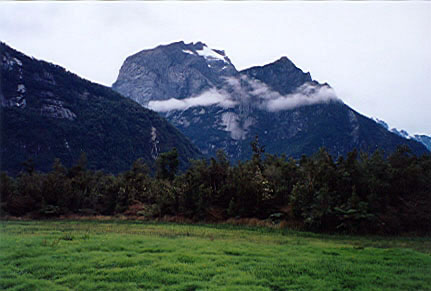

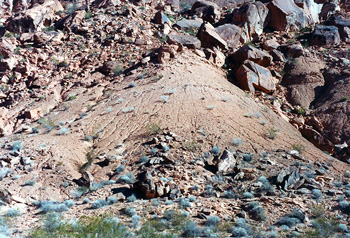
I have watched, for example, as some of the rocks that I used to make borders around the flower beds of my garden become saturated in the rain. Then, on occasion, the north wind comes blasting out of the Canadian Arctic and freezes the rocks. Although I cannot see them expand, when they thaw, I often find them split into several pieces. Awesome indeed is the hidden power and effect of ice. Cycles of wetting and drying can also break down rocks, particularly those with fine grains, although the exact mechanism is not understood.
Heating and cooling is an effective process for the gradual conversion of coarse-grained rock into smaller and smaller pieces on its journey to becoming soil. The various minerals of which a rock is composed have different capacities to absorb heat and to expand when heated. So it is that changes in temperature result in stresses that lead to fracturing along the boundaries between the minerals that make up the rock or even within some kinds of minerals themselves.
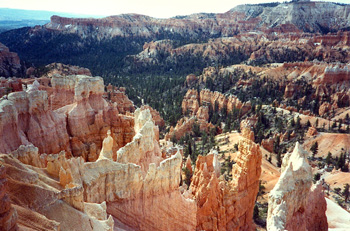
Erosion by Wind and Water in Bryce Canyon National Park, Utah.
The results of heating and cooling can be seen as the flakes loosened from exposed boulders following a forest fire or at times from the rocks used to ring a camp fire. I vividly remember one experience many years ago when I camped along a stream with a limestone bed. I collected rocks from the stream's bottom and constructed a ring in which to build my fire.
My fire, burning cheerily in the middle of the circle of rounded rocks, heated the water in the limestone, which expanded as steam. Before I knew what was happening, the limestone began exploding, which sent some fragments whizzing past my head into the night beyond, while others bombarded the flames. Fortunately, none of the flying limestone projectiles found me as their target as I scurried away from the fire.

Erosion by Wind and Water in Zion National Park, Utah.
Finally, we come to the transportation of rock. Sand blowing along a seashore or across a desert is an example of rock being transported by wind. Rocks can also be tumbled by the swift waters of streams and rivers or by the pounding surf of the ocean. And rocks can be moved by ice in glaciers. This all results in abrasion, which is yet another way rocks are reduced into progressively smaller pieces. Having dealt with the physical breakdown and transportation of rock by gravity and water, we must now turn our attention to chemical weathering, which is also driven by the environment.
Chemical Weathering
A rock's primary mineral composition reflects the temperature, pressure, and chemical makeup during its formation, often at a high temperature deep within the Earth. At the Earth's surface, where temperatures and pressures are lower, water and various organic and inorganic acids, as well as other chemical compounds, mediate a tenuous state of ever-changing balance. As rocks adjust to the environment at the Earth's surface, the primary minerals may be transformed into secondary minerals through chemical weathering.

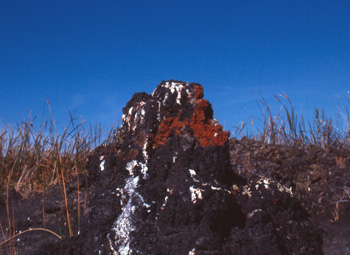
Minerals weather at different rates, depending on their chemical composition and crystalline structure. Small pieces of rock and small grains of mineral break down more rapidly than large ones because small ones have a much greater surface area compared to their mass than do large ones. For this reason, a particular rock may be more susceptible to physical decomposition than to chemical decomposition. Nevertheless, initial weathering, aided by bacteria and "rock-eating" fungi, must precede the formation of soil from hard rocks. Once soil is formed, however, the intensity of chemical breakdown is generally greater than it is in the rock itself.5
The Addition of Organic Material
Soil is a combination of four main components: minerals, water, air, and organic material. Sand, silt, and clay are the three basic building blocks of soil, whereas the water within a soil system dissolves the minerals, which constitute the primary source of nutrients for the plants. Air in the soil is needed for plant respiration and for microorganisms to obtain oxygen.
Although soil is derived from the minerals in rocks, termed "parent materials," laid down by the geological processes, as well as water and air, it is built up and enriched by the plants that live and die in it. It is further enriched by the animals that feed on the plants, void their bodily wastes, and eventually die, decay, and return to the soil as organic matter, such as little "humpety-backed" springtails and earwigs with their terminal "prongs."
Springtail
Earwig
One of the first recognizable manifestations of organic material in soil is the formation of a dark layer near the soil's surface. This organic material comes from lichens and higher plants, such as grasses and herbs, which are capable of becoming established in raw mineral soil. In fact, their presence greatly increases the rate at which soil is formed because they not only add themselves as organic material but also act as catalysts for chemical reactions.
There are distinct differences in the distribution of organic material in soils. These differences depend on climate, slope, and the type of vegetation growing on the site. Soils of grassland and prairie, for example, contrast distinctly with those of a forest in their distribution of and processes associated with organic material.
To better understand what I mean, consider the Midwestern United States, where oak forest and prairie coexist, although in distinct patches under a similar regime of climate. Both areas have a similar amount of organic material: live vegetation, vegetative litter on the surface of the soil, and organic material within the soil. But the oak forest has more than half of its total organic material tied up in the trees aboveground, whereas 90 percent of the organic material in the prairie is found within the soil.
Decomposing organic material reinvesting its nutrients into the soil of the Malaysian jungle.
As organic material is decomposed, it passes through many forms, but in the final analysis usually ends up as carbon dioxide, which is released back into the atmosphere. There are, in addition to the atmospheric releases, some relatively stable carbon compounds known as "humus," which lend soil its dark color. Humus, is the Latin word meaning "the ground, soil" or alternatively the New Latin word humos, which means "full of earth." Incorporation of organic material into the surface of the soil, where the dark layer of topsoil is formed, is rapid when considered in the scale of geological time—but exceedingly slow when considered in the scale of a human lifetime.
Molecules of humus also act as weak acids and produce the "glue," which aggregates particles of soil to form its structure, such as the pores, that allow microbiological activity to exist, as well as the infiltration of water, which flushes carbon dioxide from the soil and allows oxygen to fill the pores. The porous nature of the soil provides a mechanism for holding in place oxygen, water, and chemicals that are required for chemical interactions. In fact, the cycling of carbon through soil influences both the speed with which water can infiltrate it and how long the water can be stored before plants absorb it and "transpire" it back into the atmosphere (a plant's version of "perspiring"). In addition, soil quite literally resembles a discrete entity that lives and breathes through a complex mix of interacting organisms—from viruses and bacteria, to fungi, to earthworms and isopods (such as sowbugs), to moles, gophers, and ground squirrels. In essence, soil is perhaps the most alive part of the Earth's terrestrial habitat.6
Sowbug
The activities of all these organisms in concert are responsible for developing the critical properties that underlie the basic fertility, health, and productivity of soil. The complex, biologically driven functions of the soil, in which soil organisms are the regulators of most processes that translate into a soil's productivity, may require decades to a few centuries to develop, and there are no quick fixes if soil is extensively damaged during such activities as intensive farming. William A. Albrecht, professor of soils at the University of Missouri College of Agriculture, is often credited with being the person to fully appreciate the role of soil organic matter in maintaining soil fertility. He wrote an extensive article on this subject in 1938.7
The compaction of soil has a negative array of cascading, cumulative effects that range from decreased air and water in the soil itself to killed roots, slowing the growth of plants, suppressing the growth of mycorrhizal fungi, increasing the mortality of micro-flora and fauna—all of which reduces the productive capacity of the soil. Although soil appears to be a solid substance composed of inorganic and organic matter, which you can hold in the palm of you hand and roll around between your fingers, it's much more than that.
Healthy soil has spaces filled with air between the particles and chunks that comprise its matrix. These pockets of air are created by all the organisms living in the soil, which range from microbes to larger animals, as well as fungi and the roots of plants. Most of these organisms depend on the availability of air and water moving through the soil in order to perform their vital, ecological functions that, in concert, create and maintain the soil's health and so that of field and forest. In this sense, healthy soil acts more like than a sponge than a brick because air normally constitutes half or more of its total volume.
To clearly understand this, fill a gallon pail with intact soil from a field or forest, where no machinery has been used. If you then compress it, you will find that at least half of the volume was air. Just as we humans require air to breathe, so does every living thing in the soil. Clearly, therefore, compacting the soil, which eliminates the air and thereby increases the soil's density, is suffocating to everything that must breathe in order to live.
Compaction of soil also reduces its ability to absorb and store water, which simulates a drought for those organisms that do survive the initial compression of their habitat, particularly in fine-textured clays and silts. Over time, compacted soil is more prone to actual drought than is healthy, friable soil.8
ENDNOTES


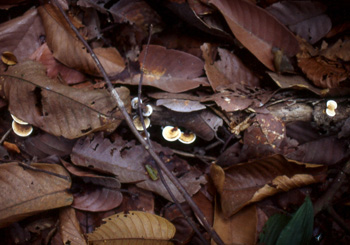



Illustrations by Paula Reid, USDA Forest Service.
©Chris Maser 2009. All rights reserved.